Biology
But wait, there's more. Plants can also communicate with one another. They alter their biochemistry to become less appealing to predatory insects or microorganisms, and their responses become better with each attack. After they develop a good defense for a particular predator, they will warn nearby members of the same species via dispersed chemicals. The warned plants then generate the best defense the first time they are attacked.
Technorati claim token TTVE88EU8BQT
- Pollen: Evolution
In this picture is pollen that got stuck to the ground because of juice or water. Pollen has been flying around because plants and flowers are blooming and they are ready to fertilize. Pollen is like a tiny grain inside id a seed plant which usually...
- Atp: Cells
This is a picture of the sun :) The sun is the greatest form of energy for living organisms on earth. The sun gives of heat energy which is a form of ATP. Plants convert this energy for photosynthesis, the light is used to produce food for itself. The...
- Sunrise, Sunset ? Life In The Twilight
Biology concepts ? activity patterns, crepuscular, co-evolution, active pollination Nocturnal and diurnal activity patterns are like vanilla and chocolate cupcakes. But what if you like rose hip or green tea flavors ? are there cupcakes out there for...
- Plants That Don?t Sleep Will Take The Dirt Nap
Biology concepts ? nastic movements, turgor pressure, evolutionary pressure, tropism, osmosis If you don?t let a Mimosa pudica (sensitive plant) plant rest at night, it will wilt away to nothing. A plant that needs a good night?s sleep? Really? We have...
- Boys Will Be Boys? And Then Girls
Biology concepts ? botany, monoecious, dichogamy, imperfect and perfect flowers, self-pollination, cross-pollination, self-incompatibility, heterostyly This clip shows the mating of hermaphroditic leopard slugs. Each may provide male gametes for...
Biology
Is It Hot In Here Or Is It Just My Philodendron?
Biology concepts ? thermoregulation, pollination, tropisms, flower structure, plant communication
In many ways, plants are ?smarter? than people (forgive the anthropomorphism). We can change our environment to suit our needs or move to a better environment. But plants can?t flip the light switch, can?t buy a bottle of water to quench their thirst, can?t turn on the air conditioner, and can?t hire a truck and move all their stuff to a better place.
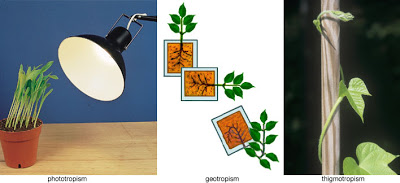 |
Plants can react to many physical signals. We can sense gravity, but they can differentiate parts of themselves with gravity ? roots grow towards gravity (positive geotropism) and stems grow away from gravity (negative geotropism). |
So what can plants do given these limitations? They can make their own food (photosynthesis) ? they?ve got us beat right there. They can turn to face the light (phototropism) or the sun (heliotropism). These abilities were explained by none other than Charles Darwin and his son in an elegant series of experiments in 1880.
Plant stems can grow away from gravity (negative geotropism or gravitism), while their roots grow toward gravity (positive geotropism) or water (hydrotropism). Finally, plants can twist around a wire and hold on (thigmotropism). Pretty talented, wouldn't you say?
Plant stems can grow away from gravity (negative geotropism or gravitism), while their roots grow toward gravity (positive geotropism) or water (hydrotropism). Finally, plants can twist around a wire and hold on (thigmotropism). Pretty talented, wouldn't you say?
But wait, there's more. Plants can also communicate with one another. They alter their biochemistry to become less appealing to predatory insects or microorganisms, and their responses become better with each attack. After they develop a good defense for a particular predator, they will warn nearby members of the same species via dispersed chemicals. The warned plants then generate the best defense the first time they are attacked.
Plants can also recognize kin ? and be nice to them. Research shows that plants grow less aggressively when surrounded by seedlings from the same mother plant compared to when surrounded by non-kin competitors. I wish I could get my kids to act that nicely towards one another.
Plants also commune with animals. The acacia tree has an arrangement with the ants that live on it. The tree produces hollow thorns for the ants to live in, and produces food for them to eat. In exchange, the ants protect the plant from predators such as caterpillars by attacking them. The ants will also prune away dead leaves and destroy nearby plants that might compete with their tree for light.
 |
The acacia tree provides hollow thorns for ants to live in; the tree?s wood is so hard that the ants can?t hollow it out on their own. The acacia wood was once used as nails. The acacia is related to the mimosa (sensitive plant) we discussed previously. |
This is a great arrangement for both ant and tree (symbiotic mutualism), but becomes tricky during pollination. The ants will attack any insect that touches their tree; even potential pollinators. So the acacia produces a chemical at the flower when an insect lands to feed on the nectar; it says, ?this guy is O.K., don?t kill him.? Amazing - I can?t get the cats to come when I call them - and I feed them! Maybe saying someone is as dumb as a potted plant isn?t much of an insult.
Plants may be ?smart? about temperature as well. They don?t regulate their own heat, and are usually the same temperature as the surrounding environment. Remember from the last post that it takes lots of energy to be an endotherm, so ectothermic plants enjoy great energy savings by adopting room temperature as their own.
A few plants can spike their temperature for a short time, usually to attract pollinators, but they can?t regulate the temperature. It is like setting a fire; it burns at as high a temperature as the fuel will allow, and then goes out.
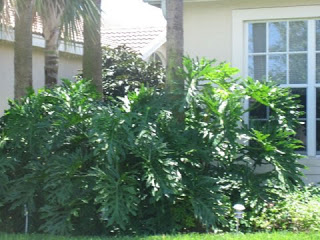 |
P. selloum grows in tropical environments, but can be found as a landscape planting in Georgia, the Carolinas, and the gulf coast. It can grow 8 meters (26 ft) tall and the leaves can be 1 meter (3 ft) in width. |
Our exception to the rule of plant ectothermy is the philodendron. Many species of this genus can raise their temperature during the period when they produce pollen, and can regulate that temperature over a short period of time (2 days). The species Philodendron selloum (P. selloum, also called Philodendron bipinnatifidum, split leaf philodendron, tree philodendron) has been the most studied and will serve as our model.
P. selloum flowers in a structure called an inflorescence. This consists of a covering spathe and a spadix in the center. The flowers are located on the spadix, with a specific arrangement of male and female flowers, making the philodendron a monoecious plant (male and female on same plant). However, the flowers are incomplete, since each individual flower has only the male (pollen producing stamen) or female (ovule containing pistil) organs.
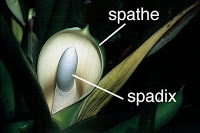 |
The flower of P. selloum is about 25 cm (10 in) tall and the flowers are plain white, as it does not use color to attract pollinators. |
The male flowers are located on the top half of the spadix, while the middle region contains sterile male flowers, and the female flowers are located at the base. This arrangement, with the sterile gap in the middle, decreases the chances that the pollinators will pollinate a female flower on the same plant (self-pollination).
Self-pollination reduces genetic diversity as the offspring are clones of the parent (we will talk more about this next time). Also to help prevent self-pollination, the male flowers produce pollen in the first evening of the anthesis; the time period when the flower is open and fully functional. The female flowers can receive pollen on the second evening.
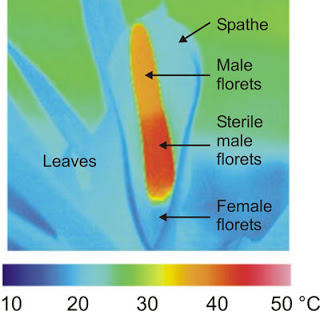 |
The spadix can reach and hold temperatures of 45 ?C (113?F) and is most concentrated in the sterile male flowers. The female flowers don?t produce heat, as this would damage the ovules. |
P. selloum raises the temperature of the spadix, specifically the male flowers. The attractant is a female beetle sex pheromone that makes male beetles of a specific species think that potential mates are on this particular flower. To maximize the effect of the pheromone, the increased temperature of the spadix volatilizes the chemical (evaporates it into the air) so it can spread a greater distance. The beetles just follow their nose back to the correct plant!
The heat comes from a special reaction within the plant. Photosynthesis is actually an endergonic (energy consuming) reaction, it eats up heat, leaving the plant cooler. But respiration (creating ATP from the carbohydrates of photosynthesis) is exorgonic (heat releasing). These two processes are basically a wash, so P. selloum needs another way to generate the heat for the spadix.
Moreover, the P. selloum heat production must correlate to the time when the pollen is mature, must be localized to the spadix, and must be regulated. To do this, the philodendron has independently evolved the same trick that human babies use to stay warm!
Babies have a big surface area compared to their volume, so they tend to lose heat rapidly. This is why parents dress babies warmer than they dress themselves. To generate more heat, babies have brown fat (brown adipose tissue or BAT). BAT has more mitochondria than regular adipose (fat) tissue, and the iron in the mitochondria make this fat appear almost brown in color. The increased mitochondrial number helps to generate more heat as the fat is metabolized.
Fat is metabolized to generate heat instead of carbohydrates because it has more energy. Fat carries almost 9 kcal/gm, while carbohydrates contain only 4 kcal/gm. This is also why fat is used to store energy, it would take more than 2.5x the volume to store the same energy if it were all in the form of carbohydrate, especially since carbohydrates are connected with water when stored, while fats are not. Being fat is actually the most compact way to store energy.
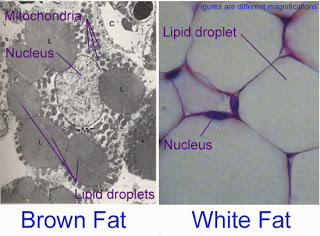 |
Brown adipose tissue (BAT) has a centrally located nucleus and several small lipid droplets in order to make room for the many mitchondria. On the right, white fat cells have an offset nucleus and are completely filled with a single lipid droplet. |
To really up the heat ante, the mitochondria have an uncoupling protein (UCP) that disconnects the burning of fat from the generation of ATP. Instead of putting some of the energy into making ATP, all the energy is put toward giving off heat. Since babies aren?t coordinated enough to exercise to increase heat, and shivering isn?t that efficient, this non-shivering thermogenesis (NST) is their way to stay warm.
It was thought that adults didn?t have BAT, but recent studies indicate that most adults have some, and some people have a lot. BAT generation can actually help keep you thin, because the BAT is more readily metabolized ?regular fat is a guard against bad times and the body holds on to it tightly, but BAT it is meant to be burned. New research suggests that chronic cold can stimulate BAT development, so forget your winter coat and just freeze your way into that size two.
P. selloum has developed BAT as well, an excellent example of convergent evolution (unrelated organisms develop similar characteristics). Plants use the alternative oxidase protein to uncouple fat metabolism from ATP generation instead of UCP, but the process is nearly the same. Using non-shivering thermogenesis, P. selloum can raise the temperature of the spadix to 104-113?F and hold it there.
More amazing, P. selloum can somehow sense the ambient temperature and keep the spadix temperature 20-30?F above that of the environment during that first evening. During the second day, the temperature is held around 80-95?F, but is not controlled so stringently. The second evening sees a slow, regulated decrease in temperature to ambient by the third morning. It's a complex mechanism, but the payoff is survival of the species.
The whole thing is pretty smart for a plant, or for any organism. Next time, we will investigate the relationship between the pollinator beetle and P. selloum, and how limiting pollination to one species of beetle breaks a rule.
Technorati claim token TTVE88EU8BQT
For more information, classroom activities, or laboratories on tropisms, pollination, plant communication, or P. selloum:
Plant tropism ?
http://plantsinmotion.bio.indiana.edu/plantmotion/movements/tropism/tropisms.html
http://www.discoveryeducation.com/teachers/free-lesson-plans/the-importance-of-tropisms.cfm
http://leavingbio.net/Plant%20Responses.htm
http://www.botanical-online.com/lasplantasmovimientosvegetalesangles.htm
http://virtualastronaut.tietronix.com/textonly/act25/text-plants.html
www.the-aps.org/education/k12curric/activities/pdfs/watson.pdf
www.spacegarden.net/downloads/Gravitropism.pdf
www.sas.upenn.edu/~ltlick/Pedagogy.pdf
www.pjteaches.com/PDF/LifeScience/labs/lab13f.pd
http://www.sciencebuddies.org/science-fair-projects/project_ideas/PlantBio_p041.shtml
http://www.hcs.ohio-state.edu/hort/biology/Lab/tropismslab.html
pollination ?
http://www.mbgnet.net/bioplants/pollination.html
http://www.fs.fed.us/wildflowers/pollinators/
http://www.brainpop.com/science/cellularlifeandgenetics/pollination/preview.weml
http://www.nbii.gov/portal/server.pt?open=512&objID=222&mode=2&in_hi_userid=2&cached=true
http://www.youtube.com/watch?v=ge3EM8AERV0
http://www.discoveryeducation.com/teachers/free-lesson-plans/plant-pollination.cfm
http://www.smithsonianeducation.org/educators/lesson_plans/partners_in_pollination/lesson1_main.html
http://ag.arizona.edu/pubs/insects/ahb/lsn43.html
www.ableweb.org/volumes/vol-22/12-puterbaugh.pdf
http://userwww.sfsu.edu/~biol240/labs/lab_13pollination/index.html
plant communication ?
http://www.sciencedaily.com/releases/2009/06/090619171244.htm
http://www.animalintelligence.org/2007/10/15/does-plant-communication-imply-intelligence/
http://www.euromed.org.uk/plant-communication.html
http://www.csrees.usda.gov/newsroom/lgunews/plants/plant_stress_signal.html
http://www.nytimes.com/2009/12/22/science/22angi.html?em
http://www.plosone.org/article/info:doi/10.1371/journal.pone.0013324
http://indianapublicmedia.org/amomentofscience/plant-communication-allergies-related/
http://www.usask.ca/education/coursework/mcvittiej/resources/livingthings/plants.htm
http://www.ted.com/talks/stefano_mancuso_the_roots_of_plant_intelligence.html
P. selloum ?
http://www.floridata.com/ref/p/phil_bip.cfm
http://faculty.ucc.edu/biology-ombrello/pow/Philodendron.htm
http://www.exoticrainforest.com/Philodendron%20bipinnatifidum%20pc.html
http://www.pburch.net/plants/C3397731/E20060506081651/
- Pollen: Evolution
In this picture is pollen that got stuck to the ground because of juice or water. Pollen has been flying around because plants and flowers are blooming and they are ready to fertilize. Pollen is like a tiny grain inside id a seed plant which usually...
- Atp: Cells
This is a picture of the sun :) The sun is the greatest form of energy for living organisms on earth. The sun gives of heat energy which is a form of ATP. Plants convert this energy for photosynthesis, the light is used to produce food for itself. The...
- Sunrise, Sunset ? Life In The Twilight
Biology concepts ? activity patterns, crepuscular, co-evolution, active pollination Nocturnal and diurnal activity patterns are like vanilla and chocolate cupcakes. But what if you like rose hip or green tea flavors ? are there cupcakes out there for...
- Plants That Don?t Sleep Will Take The Dirt Nap
Biology concepts ? nastic movements, turgor pressure, evolutionary pressure, tropism, osmosis If you don?t let a Mimosa pudica (sensitive plant) plant rest at night, it will wilt away to nothing. A plant that needs a good night?s sleep? Really? We have...
- Boys Will Be Boys? And Then Girls
Biology concepts ? botany, monoecious, dichogamy, imperfect and perfect flowers, self-pollination, cross-pollination, self-incompatibility, heterostyly This clip shows the mating of hermaphroditic leopard slugs. Each may provide male gametes for...
